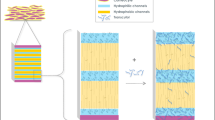Abstract
Purpose. The purpose of this study was to determine the permeation parameters of thalidomide and three of its N-alkyl analogs and to establish a correlation between the physicochemical properties of these compounds and their percutaneous rates of absorption.
Methods. In vitro permeation studies were performed from buffer, n-alkanols and various mixed components using vertical Franz diffusion cells fitted with human epidermal membranes.
Results. Measured steady-state fluxes indicate that N-methyl thalidomide is a far better penetrant of human skin than the “parent molecule”. However, fluxes through skin drop off markedly from that of the methylated compound when the chain length is extended to propyl and pentyl. However, they remain well above the flux of thalidomide, which is less than 0.025 μg/cm2/h.
Conclusions. The best skin permeant of this series was the N-methyl analog, which also exhibited the highest water (buffer) solubility compared to thalidomide, and the N-propyl and N-pentyl analogs. The N-propyl and N-pentyl analogs were more lipid soluble and exhibited higher partition coefficient values than the N-methyl analog. From all the permeability data using buffer, a series of n-alkanols and various combinations of solvents and enhancers as vehicles, the more water-soluble compound and not the more lipid soluble one was the best skin permeant.
Similar content being viewed by others
REFERENCES
E. P. Sampaio, E. N. Sarno, R. Galilly, Z. A. Cohn, and G. Kaplan. Thalidomide selectively inhibits tumor necrosis factor alpha production by stimulated human monocytes. J. Exp. Med. 173:699–703 (1991).
O. Gutiérrez-Rodríguez. Thalidomide: a promising new treatment for rheumatoid arthritis. Arthritis Rheum. 27:1118–1121 (1984).
P. Singh and M. S. Roberts. Skin permeability and local tissue concentrations of nonsteroidal anti-inflammatory drugs after topical application. J. Pharmacol. Exp. Ther. 268:144–151 (1994).
C. Goosen, T. J. Laing, J. du Plessis, T. C. Goosen, and G. L. Flynn. Physicochemical characterization and solubility analysis of thalidomide and its N-alkyl analogs. Pharm. Res. 19:13–19 (2002).
J. A. Cordero, L. Alarcon, E. Escribano, R. Obach, and J. Domenech. A comparative study of the transdermal penetration of a series of nonsteroidal antiinflammatory drugs. J. Pharm. Sci. 86: 503–508 (1997).
R. O. Potts and R. H. Guy. Predicting skin permeability. Pharm. Res. 9:663–669 (1992).
J. Hadgraft, J. du Plessis, and C. Goosen. The selection of nonsteroidal anti-inflammatory agents for dermal delivery. Int. J. Pharm. 207:31–37 (2000).
T. Yano, A. Nakagawa, M. Tsuji, and K. Noda. Skin permeability of various non-steroidal anti-inflammatory drugs in man. Life Sci. 39:1043–1050 (1986).
S. D. Roy and E. Manoukian. Permeability of ketorolac acid and its ester analogs (prodrug) through human cadaver skin. J. Pharm. Sci. 83:1548–1553 (1994).
U. Hagedorn-Leweke and B. C. Lippold. Absorption of sunscreens and other compounds through human skin in vivo: derivation of a method to predict maximum fluxes. Pharm. Res. 12:1354–1360 (1995).
B. P. Wenkers and B. C. Lippold. Skin penetration of nonsteroidal antiinflammatory drugs out of a lipophilic vehicle: influence of the viable epidermis. J. Pharm. Sci. 88:1326–1331 (1999).
O. Díez-Sales, A. C. Watkinson, M. Herráez-Domínguez, C. Javaloyes, and J. Hadgraft. A mechanistic investigation of the in vitro human skin permeation enhancing effect of Azone®. Int. J. Pharm. 129:33–40 (1996).
S. M. Harrison, B. W. Barry, and P. H. Dugard. Effects of freezing on human skin permeability. J. Pharm. Pharmacol. 36:261–264 (1984).
N. A. Megrab, A. C. Williams, and B. W. Barry. Estradiol permeation across human skin, silastic and snake skin membranes: the effects of ethanol/water co-solvent systems. Int. J. Pharm. 116:101–112 (1995).
D-D Kim, J.L. Kim, and Y.W. Chien. Mutual hairless rat skin permeation-enhancing effect of ethanol/water system and oleic acid. J. Pharm. Sci. 85:1191–1195 (1996).
R. Kadir, D. Stempler, Z. Liron, and S. Cohen. Delivery of theophylline into excised human skin from alkanoic acid solutions: A “Push-Pull” mechanism. J. Pharm. Sci. 76:774–779 (1987).
V. H. Le and B. C. Lippold. Influence of physicochemical properties of homologous esters of nicotinic acid on skin permeability and maximum flux. Int. J. Pharm. 124:285–292 (1995).
S. D. Roy, J. Fujiki, and J. S. Fleitman. Permeabilities of alkyl p-aminobenzoates through living skin equivalent and cadaver skin. J. Pharm. Sci. 82:1266–1268 (1993).
R. P. Waranis and K. B. Sloan. Effects of vehicles and prodrug properties and their interactions on the delivery of 6-mercaptopurine through skin: bisacyloxymethyl-6-mercaptopurine prodrugs. J. Pharm. Sci. 76:587–595 (1987).
F. P. Bonina, L. Montenegro, P. De Caprariis, F. Palagiano, G. Trapani, and G. Liso. In vitro and in vivo evaluation of polyoxyethylene indomethacin esters as dermal prodrugs. J. Control. Release 34:223–232 (1995).
J. Rautio, T. Nevalainen, H. Taipale, J. Vepsäläinen, J. Gynther, T. Pedersen, and T. Järvinen. Synthesis and in vitro evaluation of aminoacyloxyalkyl esters of 2-(6-methoxy-2-naphthyl)propionic acid as novel naproxen prodrugs for dermal drug delivery. Pharm. Res. 16:1172–1178 (1999).
Author information
Authors and Affiliations
Corresponding author
Rights and permissions
About this article
Cite this article
Goosen, C., Laing, T.J., du Plessis, J. et al. Percutaneous Delivery of Thalidomide and Its N-Alkyl Analogs. Pharm Res 19, 434–439 (2002). https://doi.org/10.1023/A:1015183310000
Issue Date:
DOI: https://doi.org/10.1023/A:1015183310000




